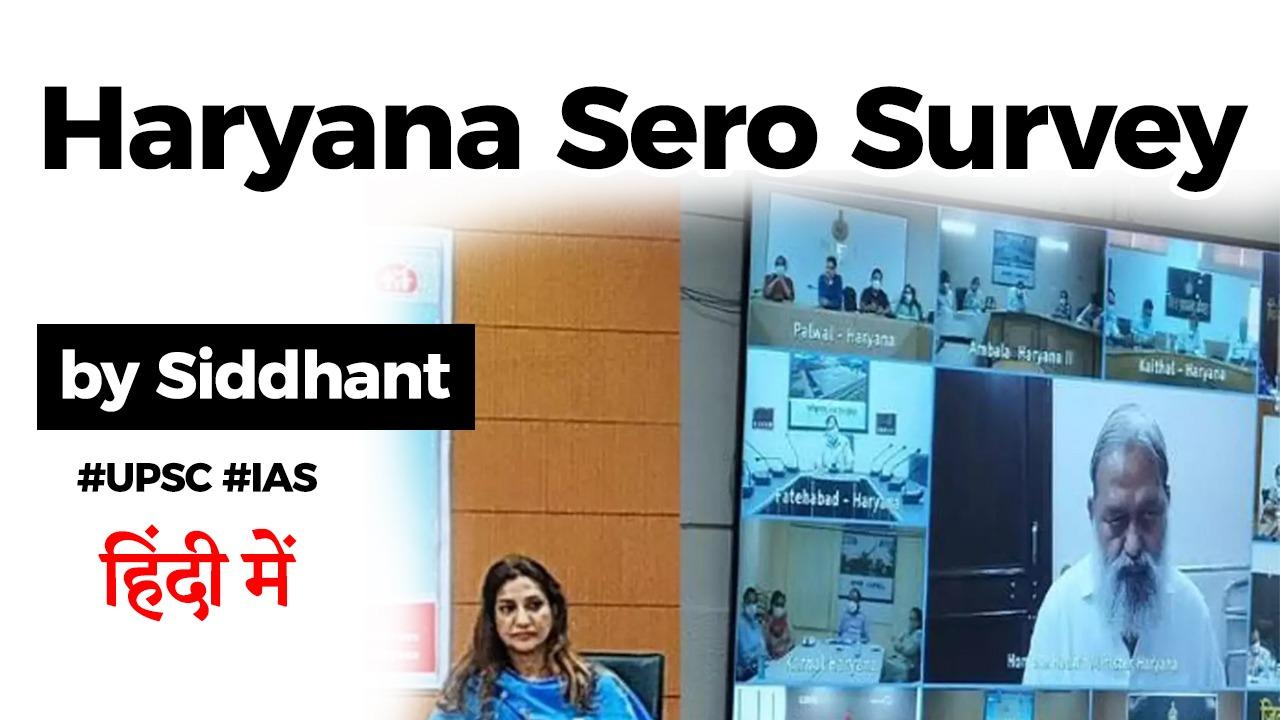Table of Contents
SEROSURVEY
Despite a high recovery rate of 82.91 per cent, Haryana continues to witness a spike in new cases of coronavirus infections across all the districts.
SEROSURVEY
- Amid rising cases of coronavirus infections across the state, the Haryana government will launch a state-wide Sero-survey from August 17.
- In collaboration with PGIMER, Chandigarh, the survey will be conducted in all 22 districts till August 20.
WHY HARYANA FELT THE NEED FOR A STATE-WIDE SERO SURVEY?
Despite a high recovery rate of 82.91 per cent, the state continues to witness a spike in new cases of coronavirus infections across all the districts.
What does Haryana want to achieve from this Sero-survey?
- A Sero-survey was conducted in May by ICMR in 83 districts that included Kurukshetra in Haryana. Similarly, NCDC conducted a Sero-survey in Delhi.
- On similar patterns, Haryana will conduct its survey in all 22 districts by using lgG ELISA Test kits. The main aim of the survey is to monitor exposure of general population to Coronavirus infection in Haryana and to estimate the sero-prevalence of anti Sars Cov-2 lgG antibodies among population of the state.
What is the methodology being adopted and what shall be the sampling design?
- The sample size shall be estimated at the district level with 850 participants from each district. These samples – 850 participants – will be divided into two stratas – Rural and Urban.
- Haryana’s ratio of rural to urban is roughly around 60:40. The 850 participants would be divided into two clusters – 500 (rural) and 350 (urban).
What is the methodology being adopted and what shall be the sampling design?
- Urban Areas will further be divided into four clusters and each cluster shall susbequently be divided into four quadrants. A total of 88 samples will be taken from every cluster – 22 households from each of the four quadrants.
- Similarly, rural areas shall be divided into 12 clusters and each cluster into four quadrants. A total of 44 samples will be taken from each cluster – 11 households from each quadrant.
Who all shall be included among the participants?
- Anybody above 18 years can be included as a participant with their consent. One individual in each household shall be selected.
Who all shall comprise the team for conducting Sero-survey?
- For each cluster, there will be one team comprising one medical officer (MBBS, BDS or AYUSH), one healthcare worker of ANM/ LHV level preferable of the selected health facility, one laboratory technician or trained phlebotomist and one supervisor for every two clusters (DSO/ Deputy Civil Surgeon).
How are the teams being trained?
- A basic training shall be given to the health officer and field teams using digital mode. This will involve informing them about the overall objectives of the survey, how to select the GPS cluster point within a selected cluster, how to select the first house, how to approach the family and take consent, how to fill the form using digital mode, how to prepare blood sample collection kit including vacutainers and how to draw blood samples, label, transport and store them.
What shall be the procedure for sample collection?
- The study teams will visit the randomly selected households and brief them about the survey. A verbal consent will be taken.
- Doctor in the team will ask the questions and the other person will record on the form. At the end of the interview, the doctor will cross check the form for its completeness and correctness.
- At the end of the interview, laboratory technician will draw 5ml blood, label it and store it.
What is the outcome that state expects out of this Sero-survey?
- “The study will help the state determine the burden of Covid-19 infection at the community level and monitor the trends in transmission of SARS-COV-2 infection.
- The study findings will be useful to guide in designing and implementing appropriate containment measures.
What will be PGIMER’s role in the survey?
PGIMER is required to do the protocol preparation, conduct the training and mentorship, provide the quality assurance, data compilation and report presentation and submission of final report for dissemination. There will, however, be no financial liability on the institute.
Latest Burning Issues | Free PDF






















 WhatsApp
WhatsApp